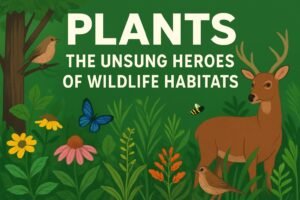India is not only a land of tigers and elephants but also a paradise for delicate winged creatures—butterflies. With over 1,300 species of butterflies fluttering across the country, India has established several Butterfly Parks to conserve and showcase these beautiful insects. These parks offer a rich biodiversity experience, making them educational, ecological, and eco-tourism hotspots.

Why Butterfly Parks are Important
- Conservation of Native Species
Many butterfly species are endangered due to habitat loss, pollution, and climate change. These parks provide them a safe environment. - Pollination Support
Butterflies are important pollinators like bees. They help in the growth of flowering plants and food crops. - Educational Value
Butterfly parks educate children and adults about biodiversity, conservation, and natural ecosystems. - Eco-Tourism Development
These parks attract tourists and nature enthusiasts, promoting eco-tourism and generating income for local communities.
Famous Butterfly Parks in India
Here’s a list of the most notable butterfly parks and gardens across India:
| Butterfly Park | Location | Key Highlights |
|---|---|---|
| Bannerghatta Butterfly Park | Bangalore, Karnataka Location | India’s first butterfly park; dome-shaped conservatory, museum, and audiovisual room. |
| Sikkim Butterfly Park | Rangpo, Sikkim Location | Located in Himalayan Biodiversity Hotspot; home to rare species like Kaiser-i-Hind. |
| Butterfly Garden, Chandigarh | Chandigarh Loacation | Spread across 7 acres; specially cultivated nectar and host plants. |
| Assam State Zoo Butterfly Park | Guwahati, Assam | Over 60 butterfly species; located inside Assam State Zoo. |
| Yashwantrao Chavan Butterfly Garden | Pune, Maharashtra Location | Over 60 species; special educational tours for students. |
| Bhoj Wetland Butterfly Park | Bhopal, Madhya Pradesh Location | Located near Bhojtal Lake; beautiful scenic surroundings. |
| Malshej Ghat Butterfly Garden | Malshej Ghat, Maharashtra | Natural setting with a large number of wild butterflies. |
| Tropical Butterfly Conservatory | Trichy, Tamil Nadu | Asia’s largest butterfly park (25 acres); more than 25,000 butterfly species planted. |
| Vandalur Butterfly Park | Chennai, Tamil Nadu | Located inside Arignar Anna Zoological Park. |
| Sayaji Baug Butterfly Park | Vadodara, Gujarat | Developed inside the Sayaji Garden, housing many native species. |
Popular Butterfly Species Found in India
India is home to a vibrant range of butterfly species, including:
| Common Name | Scientific Name | Region |
|---|---|---|
| Common Mormon | Papilio polytes | Pan India |
| Blue Tiger | Tirumala limniace | South and Western Ghats |
| Common Jezebel | Delias eucharis | Throughout India |
| Tailed Jay | Graphium agamemnon | Western Ghats, NE India |
| Indian Leaf Butterfly | Kallima inachus | Himalayan and Eastern region |
| Southern Birdwing | Troides minos | South India (Largest butterfly in India) |
| Common Crow | Euploea core | All over India |
| Crimson Rose | Pachliopta hector | Western and Eastern Ghats |
Types of Plants Grown in Butterfly Parks
Butterfly parks are designed with two types of plants:
- Nectar Plants – For adult butterflies to feed on:
- Lantana
- Ixora
- Zinnia
- Marigold
- Pentas
- Host Plants – For caterpillars to feed and grow:
- Citrus (for Common Mormon)
- Curry leaves
- Pipevine
- Cassia
- Milkweed
Attractions in a Butterfly Park
- Butterfly dome or conservatory
- Live breeding labs to show metamorphosis
- Educational exhibitions and interactive sessions
- Nature trails and photography zones
- Signage and posters with butterfly facts
- Quiet sitting areas for observation
Did You Know?
- Butterflies use their feet to taste!
- The lifespan of a butterfly ranges from a week to a month.
- A butterfly’s wings are made of tiny scales that reflect light, giving them their shimmering colors.
- The Southern Birdwing is India’s largest butterfly with a wingspan of up to 19 cm!
Conclusion
Butterfly Parks in India are not just tourist spots, they are biodiversity treasures that highlight the ecological balance and delicate beauty of nature. They inspire conservation, education, and a deep appreciation of wildlife, especially for younger generations. Next time you plan a getaway, consider visiting one of these parks to experience a fluttering paradise of colors.
Explore More on Wildlife
For more such fascinating wildlife destinations and animal facts, visit
🌐 www.wildlifenest.com – your ultimate guide to wildlife in India.
Frequently Asked Questions – Butterfly Parks in India
1. What is a butterfly park?
A butterfly park is a specially designed garden or conservatory where butterflies are bred, conserved, and allowed to fly freely in a natural-like environment. These parks include nectar plants, host plants, and shelters to support their full life cycle.
2. How many butterfly species are found in India?
India is home to over 1,300 species of butterflies, making it one of the most butterfly-rich countries in the world.
3. Which is the first butterfly park in India?
The Bannerghatta Butterfly Park in Bangalore, Karnataka, is India’s first butterfly park, established in 2006.
4. What is the largest butterfly park in India?
The Tropical Butterfly Conservatory in Trichy, Tamil Nadu, is the largest in India, spread across 25 acres, with thousands of butterfly-friendly plants.
5. Which are the best butterfly parks to visit in India?
Some of the best butterfly parks in India include:
- Bannerghatta Butterfly Park (Bangalore)
- Tropical Butterfly Conservatory (Trichy)
- Butterfly Garden (Chandigarh)
- Yashwantrao Chavan Garden (Pune)
- Vandalur Zoo Butterfly Park (Chennai)
6. What is the entry fee for butterfly parks in India?
Entry fees vary by location. For example:
- Bannerghatta Butterfly Park: ₹30 to ₹50 approx.
- Tropical Butterfly Conservatory: ₹10 to ₹30 approx.
Check local websites or tourism boards for current prices.
7. What types of butterflies can I see in these parks?
You can find popular Indian butterflies such as:
- Common Mormon
- Blue Tiger
- Crimson Rose
- Southern Birdwing
- Tailed Jay
- Indian Leaf Butterfly
8. What do butterflies eat in these parks?
Butterflies feed on nectar from flowers, which is why butterfly parks are planted with nectar-rich flowers like lantana, ixora, and marigold. Caterpillars feed on host plants like curry leaves and citrus.
9. Can children visit butterfly parks?
Yes! Butterfly parks are family-friendly and educational, perfect for school trips, kids, and nature enthusiasts.
10. Are photography and videography allowed?
Yes, photography is usually allowed, but flash photography may be restricted to avoid disturbing the butterflies. Always follow park rules.
11. When is the best time to visit a butterfly park?
The best time to visit is during morning hours on sunny days, especially between September to March, when butterflies are most active.
12. How do butterfly parks help in conservation?
Butterfly parks help conserve endangered species, raise public awareness, and support the ecosystem by encouraging pollination and preserving biodiversity.
You can explore more about these snakes on our website:
| Snake Name | Read More |
|---|---|
| Cobra Snake | Cobra Snake Information |
| Russell’s Viper | Russell’s Viper Snake Info |
| Common Krait | Common Krait Snake Info |
| Saw-scaled Viper | Saw-scaled Viper Info |


